Unit 10 You're supposed to shake hands. Section B (1a~1d)课件(30张PPT)+内嵌音视频
文档属性
| 名称 | Unit 10 You're supposed to shake hands. Section B (1a~1d)课件(30张PPT)+内嵌音视频 |  | |
| 格式 | pptx | ||
| 文件大小 | 128.7MB | ||
| 资源类型 | 教案 | ||
| 版本资源 | 人教新目标(Go for it)版 | ||
| 科目 | 英语 | ||
| 更新时间 | 2024-01-12 21:11:10 | ||
图片预览

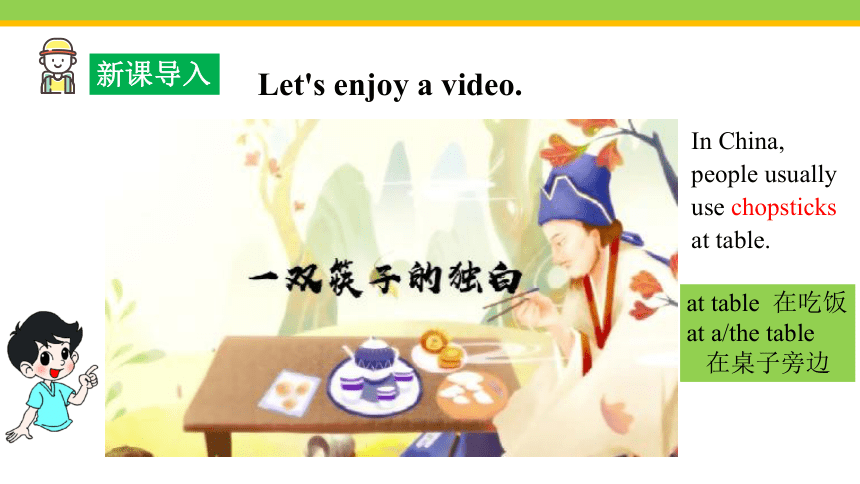
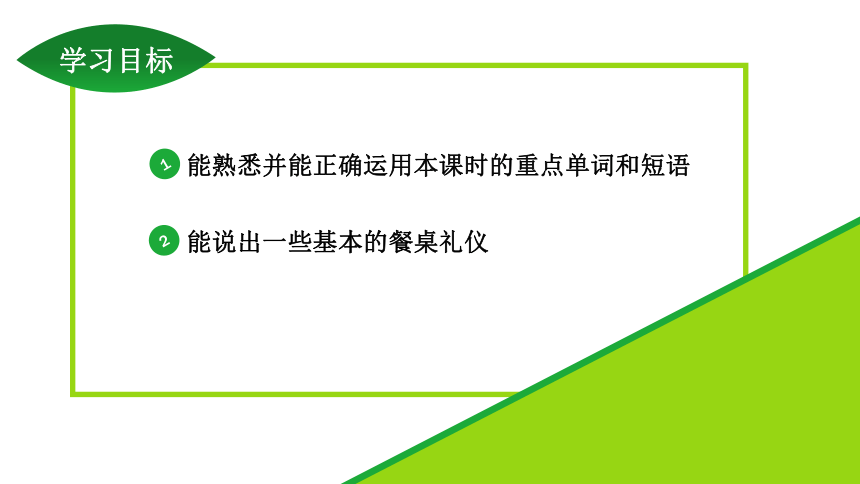

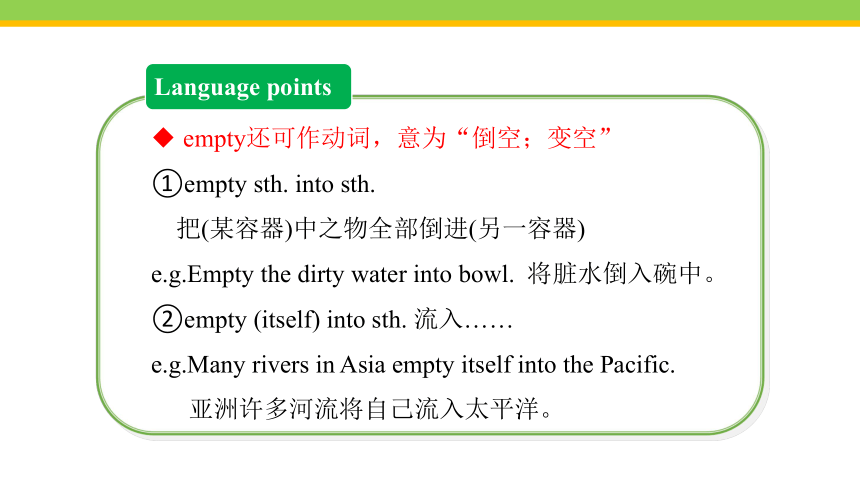
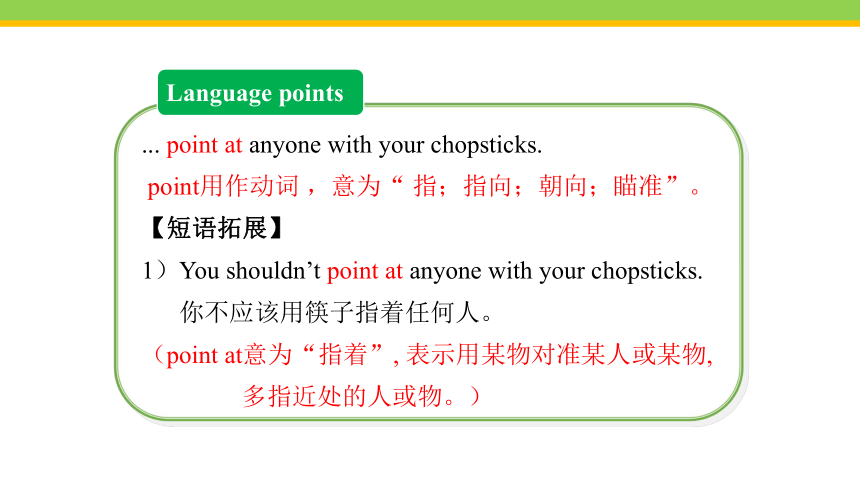
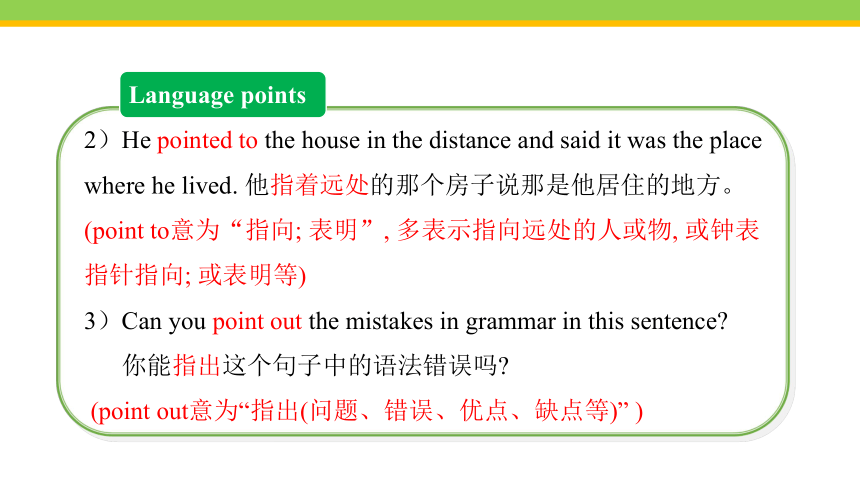
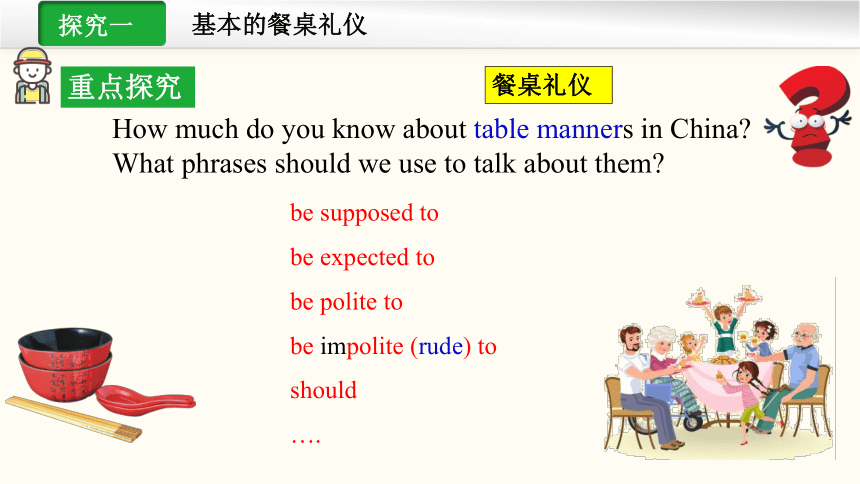
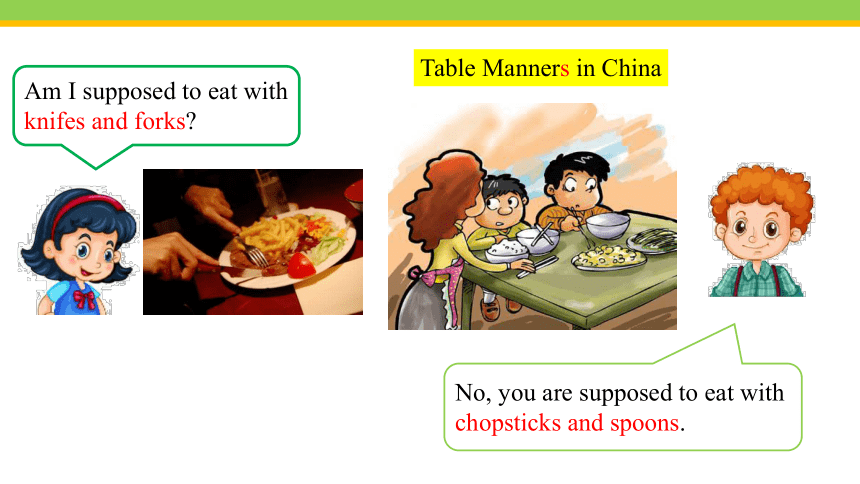
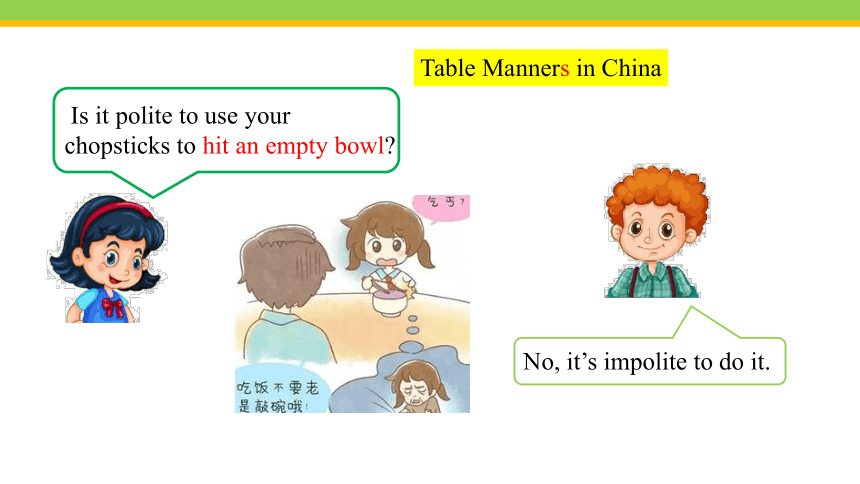
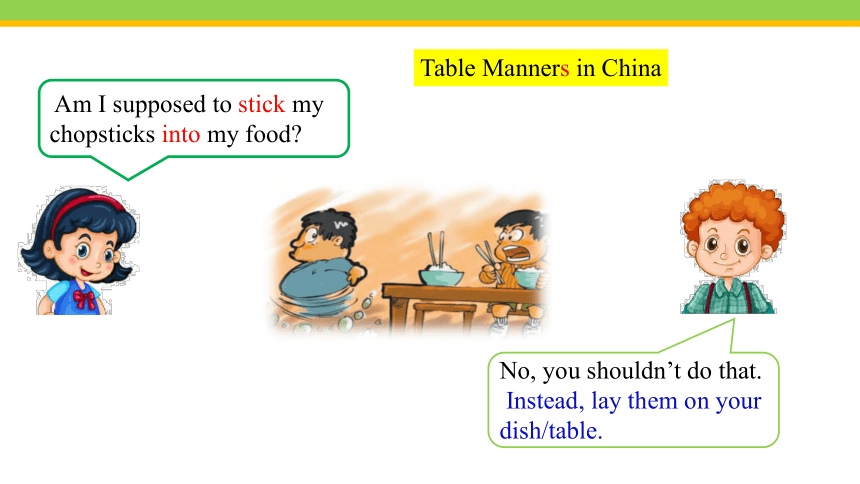
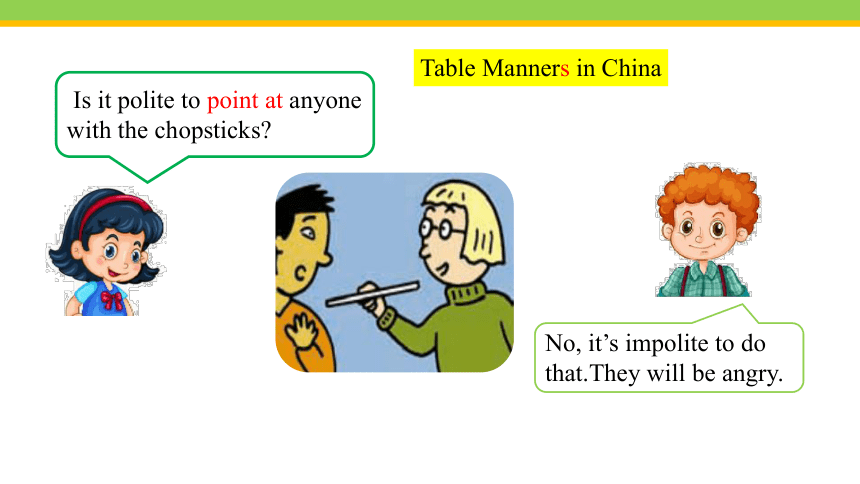
文档简介
(共30张PPT)
Unit 10
You're supposed to shake hands.
Section B (1a~1d)
新课导入
Let's enjoy a video.
In China, people usually use chopsticks at table.
at table 在吃饭
at a/the table
在桌子旁边
2
1
能熟悉并能正确运用本课时的重点单词和短语
能说出一些基本的餐桌礼仪
知识梳理
Language points
In China, it's impolite to use your chopsticks to hit an empty bowl.
在中国,用筷子打一个空碗是不礼貌的。
empty 作形容词,意为“空的;空洞的;空虚的;空腹的”
e.g. His room is empty.
他的房间是空的。
His speech is empty.
他的讲话很空洞。
Language points
empty还可作动词,意为“倒空;变空”
①empty sth. into sth.
把(某容器)中之物全部倒进(另一容器)
e.g.Empty the dirty water into bowl. 将脏水倒入碗中。
②empty (itself) into sth. 流入……
e.g.Many rivers in Asia empty itself into the Pacific.
亚洲许多河流将自己流入太平洋。
Language points
... point at anyone with your chopsticks.
point用作动词 ,意为“ 指;指向;朝向;瞄准”。
【短语拓展】
1)You shouldn’t point at anyone with your chopsticks.
你不应该用筷子指着任何人。
(point at意为“指着”, 表示用某物对准某人或某物,
多指近处的人或物。)
Language points
2)He pointed to the house in the distance and said it was the place where he lived. 他指着远处的那个房子说那是他居住的地方。
(point to意为“指向; 表明”, 多表示指向远处的人或物, 或钟表指针指向; 或表明等)
3)Can you point out the mistakes in grammar in this sentence
你能指出这个句子中的语法错误吗
(point out意为“指出(问题、错误、优点、缺点等)” )
重点探究
基本的餐桌礼仪
How much do you know about table manners in China
What phrases should we use to talk about them
be supposed to
be expected to
be polite to
should
….
be impolite (rude) to
餐桌礼仪
Am I supposed to eat with knifes and forks
No, you are supposed to eat with chopsticks and spoons.
Table Manners in China
Is it polite to use your chopsticks to hit an empty bowl
No, it’s impolite to do it.
Table Manners in China
Am I supposed to stick my chopsticks into my food
No, you shouldn’t do that.
Instead, lay them on your dish/table.
Table Manners in China
Is it polite to point at anyone with the chopsticks
No, it’s impolite to do that.They will be angry.
Table Manners in China
Is it polite to stand for food while eating
No, it’s impolite.You shouldn’t reach across the table to get something to eat.
Table Manners in China
Am I supposed to talk and laugh loudly while eating
No, it’s rude to talk with your mouth full.
…
Table Manners in China
Is it polite to start eating first if there are older people at the table
No, it’s polite to let the older start eating first.
先吃了
Table Manners in China
There are many table manners around the world, but different countries have different customs.
In Japan
You are supposed to make noise while eating noodles. It shows that you like the food.
In America
You’re not supposed to make noise while eating noodles.It's very impolite.
In America
You’re not supposed to eat with your hands.You should use a knife and fork.
In India, you’re supposed to eat
with your hands.
In India
In France,You’re supposed to put your bread on the table.
In France
You’re not supposed to eat with your hands.
You should use a knife and fork.
In Korea
Even the youngest person isn’t supposed to start eating first.
In Brazil
You should wipe your mouth with your napkin every time
you take a drink.
1a How much do you know about table manners around the world Take the following quiz. Circle T for true or F for false after each sentence.
Mind your manners!
1. In India, you’re supposed to eat with your hands. T F
2. In China, you’re not supposed to stick your chopsticks into the food. T F
3. In Korea, the youngest person is expected to start eating first. T F
4. In France, you’re supposed to put your bread on the table. T F
5. In China, it’s impolite to use your chopsticks to hit an empty bowl. T F
Pre-listening
Describe the three pictures in 1b.
There is a bowl of rice on the table. Someone sticks a pair of chopsticks into the food.
There are three people in the picture. The young man is eating. The old man seems unhappy.
There are two children in the picture. They are talking. The girl is pointing at the boy with her chopsticks.
1b Steve is going to China to study. His friend Yang Ming is telling him about the table manners in China. Listen and number the pictures in the order you hear them.
2
1
3
1c Listen again. Match the sentence parts.
____ 1. You’re not supposed to… ____ 2. It’s impolite to… ____ 3. You shouldn’t… a. stick your chopsticks into your food.
b. point at anyone with your chopsticks.
c. start eating first if there are older people at the table.
a
c
b
Can you tell us something about Steve
1.Where will Steve go tomorrow
2. How does he feel
3. What’s the matter
He will go to China tomorrow.
He feels excited and nervous.
He doesn’t know how to use chopsticks
very well and how to behave at the dinner table.
1d Talk about other table manners in your country.
A: We are supposed to…
B: Yes, and it’s impolite to…
Pair work
Useful expressions:
We are supposed to … / We are not supposed to …
We should / shouldn’t …
It’s polite...
It’s impolite/ rude to …
We are allowed to …
We aren’t allowed to …
We can / could / can’t / couldn’t …
小组展示
1 组
2 组
3 组
4 组
活动小结
通过以上的活动,我们了解了不同国家的基本的餐桌礼仪。
如:In India, you're supposed to_______________________;
In China, you're not supposed to_______________________;
In Korea,you're not supposed to______________ if there are
older people at the table;
In France, you're supposed to_______________________.
start eating first
eat with your hands
stick chopsticks into the food
put your bread on the table
课堂总结
重点单词/短语:
empty a.形容词, 空的;
空洞的;空虚的;空腹的;
b.动词, 倒空;变空;
point 动词,指; 指向; 瞄准
point at 指着
point to 指向; 表明
point out 指出
能说出一些不同国家的
基本的餐桌礼仪
Unit 10 Section B (1a~1d)
Unit 10
You're supposed to shake hands.
Section B (1a~1d)
新课导入
Let's enjoy a video.
In China, people usually use chopsticks at table.
at table 在吃饭
at a/the table
在桌子旁边
2
1
能熟悉并能正确运用本课时的重点单词和短语
能说出一些基本的餐桌礼仪
知识梳理
Language points
In China, it's impolite to use your chopsticks to hit an empty bowl.
在中国,用筷子打一个空碗是不礼貌的。
empty 作形容词,意为“空的;空洞的;空虚的;空腹的”
e.g. His room is empty.
他的房间是空的。
His speech is empty.
他的讲话很空洞。
Language points
empty还可作动词,意为“倒空;变空”
①empty sth. into sth.
把(某容器)中之物全部倒进(另一容器)
e.g.Empty the dirty water into bowl. 将脏水倒入碗中。
②empty (itself) into sth. 流入……
e.g.Many rivers in Asia empty itself into the Pacific.
亚洲许多河流将自己流入太平洋。
Language points
... point at anyone with your chopsticks.
point用作动词 ,意为“ 指;指向;朝向;瞄准”。
【短语拓展】
1)You shouldn’t point at anyone with your chopsticks.
你不应该用筷子指着任何人。
(point at意为“指着”, 表示用某物对准某人或某物,
多指近处的人或物。)
Language points
2)He pointed to the house in the distance and said it was the place where he lived. 他指着远处的那个房子说那是他居住的地方。
(point to意为“指向; 表明”, 多表示指向远处的人或物, 或钟表指针指向; 或表明等)
3)Can you point out the mistakes in grammar in this sentence
你能指出这个句子中的语法错误吗
(point out意为“指出(问题、错误、优点、缺点等)” )
重点探究
基本的餐桌礼仪
How much do you know about table manners in China
What phrases should we use to talk about them
be supposed to
be expected to
be polite to
should
….
be impolite (rude) to
餐桌礼仪
Am I supposed to eat with knifes and forks
No, you are supposed to eat with chopsticks and spoons.
Table Manners in China
Is it polite to use your chopsticks to hit an empty bowl
No, it’s impolite to do it.
Table Manners in China
Am I supposed to stick my chopsticks into my food
No, you shouldn’t do that.
Instead, lay them on your dish/table.
Table Manners in China
Is it polite to point at anyone with the chopsticks
No, it’s impolite to do that.They will be angry.
Table Manners in China
Is it polite to stand for food while eating
No, it’s impolite.You shouldn’t reach across the table to get something to eat.
Table Manners in China
Am I supposed to talk and laugh loudly while eating
No, it’s rude to talk with your mouth full.
…
Table Manners in China
Is it polite to start eating first if there are older people at the table
No, it’s polite to let the older start eating first.
先吃了
Table Manners in China
There are many table manners around the world, but different countries have different customs.
In Japan
You are supposed to make noise while eating noodles. It shows that you like the food.
In America
You’re not supposed to make noise while eating noodles.It's very impolite.
In America
You’re not supposed to eat with your hands.You should use a knife and fork.
In India, you’re supposed to eat
with your hands.
In India
In France,You’re supposed to put your bread on the table.
In France
You’re not supposed to eat with your hands.
You should use a knife and fork.
In Korea
Even the youngest person isn’t supposed to start eating first.
In Brazil
You should wipe your mouth with your napkin every time
you take a drink.
1a How much do you know about table manners around the world Take the following quiz. Circle T for true or F for false after each sentence.
Mind your manners!
1. In India, you’re supposed to eat with your hands. T F
2. In China, you’re not supposed to stick your chopsticks into the food. T F
3. In Korea, the youngest person is expected to start eating first. T F
4. In France, you’re supposed to put your bread on the table. T F
5. In China, it’s impolite to use your chopsticks to hit an empty bowl. T F
Pre-listening
Describe the three pictures in 1b.
There is a bowl of rice on the table. Someone sticks a pair of chopsticks into the food.
There are three people in the picture. The young man is eating. The old man seems unhappy.
There are two children in the picture. They are talking. The girl is pointing at the boy with her chopsticks.
1b Steve is going to China to study. His friend Yang Ming is telling him about the table manners in China. Listen and number the pictures in the order you hear them.
2
1
3
1c Listen again. Match the sentence parts.
____ 1. You’re not supposed to… ____ 2. It’s impolite to… ____ 3. You shouldn’t… a. stick your chopsticks into your food.
b. point at anyone with your chopsticks.
c. start eating first if there are older people at the table.
a
c
b
Can you tell us something about Steve
1.Where will Steve go tomorrow
2. How does he feel
3. What’s the matter
He will go to China tomorrow.
He feels excited and nervous.
He doesn’t know how to use chopsticks
very well and how to behave at the dinner table.
1d Talk about other table manners in your country.
A: We are supposed to…
B: Yes, and it’s impolite to…
Pair work
Useful expressions:
We are supposed to … / We are not supposed to …
We should / shouldn’t …
It’s polite...
It’s impolite/ rude to …
We are allowed to …
We aren’t allowed to …
We can / could / can’t / couldn’t …
小组展示
1 组
2 组
3 组
4 组
活动小结
通过以上的活动,我们了解了不同国家的基本的餐桌礼仪。
如:In India, you're supposed to_______________________;
In China, you're not supposed to_______________________;
In Korea,you're not supposed to______________ if there are
older people at the table;
In France, you're supposed to_______________________.
start eating first
eat with your hands
stick chopsticks into the food
put your bread on the table
课堂总结
重点单词/短语:
empty a.形容词, 空的;
空洞的;空虚的;空腹的;
b.动词, 倒空;变空;
point 动词,指; 指向; 瞄准
point at 指着
point to 指向; 表明
point out 指出
能说出一些不同国家的
基本的餐桌礼仪
Unit 10 Section B (1a~1d)
同课章节目录
- Unit 1 How can we become good learners.
- Section A
- Section B
- Unit 2 I think that mooncakes are delicious!
- Section A
- Section B
- Unit 3 Could you please tell me where the restroom
- Section A
- Section B
- Unit 4 I used to be afraid of the dark.
- Section A
- Section B
- Unit 5 What are the shirts made of?
- Section A
- Section B
- Review of Units 1-5
- Unit 6 When was it invented?
- Section A
- Section B
- Unit 7 Teenagers should be allowed to choose their
- Section A
- Section B
- Unit 8 It must belong to Carla.
- Section A
- Section B
- Unit 9 I like music that I can dance to.
- Section A
- Section B
- Unit 10 You're supposed to shake hands.
- Section A
- Section B
- Review of Units 6-10
- Unit 11 Sad movies make me cry.
- Section A
- Section B
- Unit 12 Life is full of the unexpected
- Section A
- Section B
- Unit 13 We're trying to save the earth!
- Section A
- Section B
- Unit 14 I remember meeting all of you in Grade 7.
- Section A
- Section B
- Review of Units 11-14
